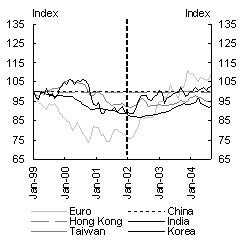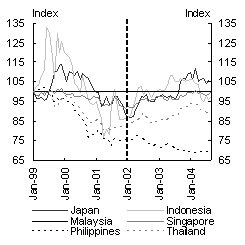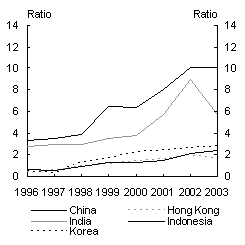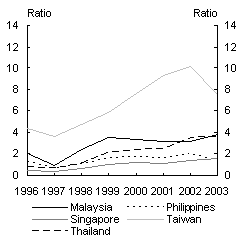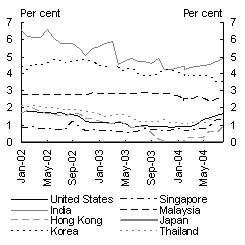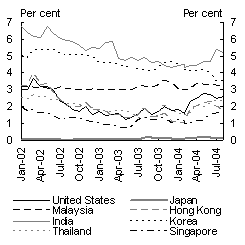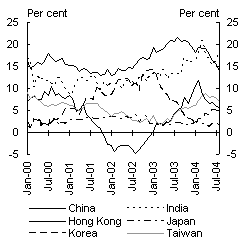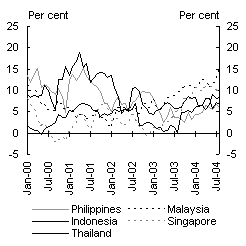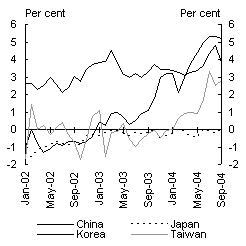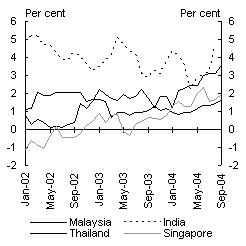Phil Garton1
Asian governments have been accumulating foreign reserves (largely United States securities) on a large scale, as a result of maintaining fixed exchange rates or attempting to limit currency appreciation in the face of a weakening US dollar. There has been considerable international discussion on Asia’s capacity to maintain this approach and the implications for United States current account adjustment.
The effects on Asia to date appear relatively benign. More expansionary monetary conditions have helped some economies that were experiencing actual or near-deflation not long ago. Monetary authorities have been reasonably successful in maintaining monetary control through sterilisation operations without pushing up interest rates.
This situation is unlikely to be sustainable in the long term, as sterilisation on the recent scale cannot be maintained indefinitely. Ultimately, policy-makers cannot fix the real exchange rate. If economic fundamentals require a real appreciation, this will eventually occur through either nominal appreciation or higher inflation.
Introduction
Large-scale accumulation of foreign (largely US dollar) reserves by Asian economies has attracted considerable international attention over the past year or so. This accumulation is commonly attributed to Asian governments maintaining fixed exchange rates or trying to limit their currency’s appreciation in the face of a depreciating USdollar.
This article examines the sustainability of this policy approach for Asia. Its primary focus is not on whether these policies have been optimal to date. Nor does it attempt to assess the implications for the rest of the world; in particular, for the sustainability of the United States current account. Instead, it starts from the premise that Asian policymakers have perceived benefits in resisting currency appreciation to date, and assesses whether they might continue to do so without imposing increasing costs on their economies. If the costs of maintaining the policy continually increase relative to the benefits, then policy can be expected to change at some point.
Foreign reserve accumulation in Asia: Key developments
Drivers of Asian reserve accumulation
Total Asian foreign reserves have increased from US$1.2 trillion at 31December2001 to US$2.2 trillion at 30 September 2004. Monthly reserve accumulation peaked between September 2003 and March 2004, before easing from April (Chart 1).2 Japan has been the largest contributor to the rise and subsequent slowing in reserve accumulation. China and the rest of Asia have also been significant, although the recent fall in Chinese accumulation has been less marked. A key factor underlying the recent fall appears to have been the partial recovery of the US dollar in recent months. This reduces the need to accumulate reserves to maintain a given exchange rate.
For economies pegged to a depreciating US dollar (China, Hong Kong and Malaysia), reserve accumulation has resulted automatically from the authorities’ pledge to buy foreign exchange as necessary to maintain the fixed rate. For those with managed exchange rates, it reflects discretionary intervention in the foreign exchange market.
Chart 1: Monthly change in foreign reserves
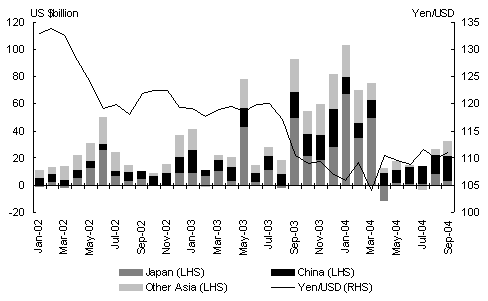
Source: CEIC. Other Asia is the sum of flows for Korea, Taiwan, Hong Kong, India, Thailand, Malaysia, Singapore, Indonesia and the Philippines. Other Asia data for September 2004 does not include Indonesia.
Balance of payments (BoP) data, which exclude valuation effects, indicate flows into Asian reserves totalled around US$460 billion in 2003 and US$295 billion in the first half of 2004 (Chart 2). These flows correspond to surpluses on the overall balance of payments (the sum of current and capital accounts).
Chart 2: Contributions to Asian reserve flows
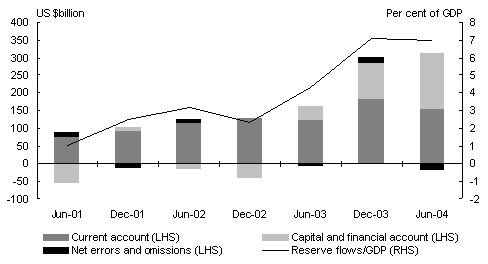
Source: CEIC. Total of flows for economies included in Chart 1. There is no data for Indonesia prior to March2002.
The main factor driving the increase in reserve flows up to the March quarter of 2004 was a turnaround from net outflows of non-FDI capital to net inflows, which reversed in the June quarter.
How large are Asian official purchases of United States assets?
The role of Asian central banks in financing the United States current account deficit has attracted a lot of attention. Data on currency composition of foreign reserves are not publicly available, but other data sources provide an indication of the extent of purchases of United States assets.
United States BoP data show that Asian official purchases of United States assets totalled US$301billion over the year to June 2004. These purchases have accounted for around half of net capital and financial account flows into the United States since the March quarter of 2003, offsetting most of the fall in net non-official flows over this period (Chart 3). In net flow terms, Asian official purchases have accounted for about 30percent of foreign purchases of United States assets in recent quarters.
Chart 3: Composition of United States net capital and
financial account flows
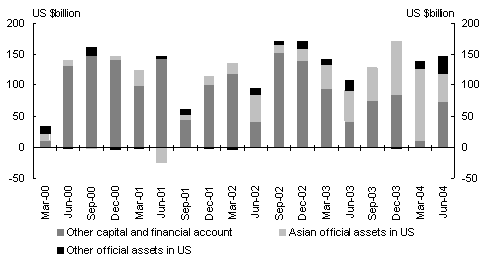
Source: Bureau of Economic Analysis.
These data actually understate the importance of Asian official purchases, as they cover only purchases from United States residents. Hence, they do not capture purchases of United States securities in offshore secondary markets. The Asian BoP data suggest that Asian official purchases of United States assets may have totalled at least US$410 billion in 2003, assuming at least 90percent of reserve purchases were USdollar assets.3 This would imply that almost half of foreign purchases of United States assets in 2003 ended up in the hands of Asian central banks. In net flow terms, Asian official purchases may have amounted to around three-quarters of the United States current account deficit in 2003.
Has foreign reserve accumulation been sterilised?
Official purchases of foreign reserves increase the monetary base (currency held by the public plus deposits with the central bank), unless they are ‘sterilised’ by offsetting sales of government securities by the central bank. Prolonged unsterilised intervention is eventually likely to feed into higher inflation. This would mean a real appreciation, even if nominal exchange rates were unchanged.
We can gauge whether monetary effects of intervention have been offset by comparing growth in the monetary base (reserve money) with the contribution to growth implied by the change in net foreign assets held by monetary authorities. If the latter figure is higher this indicates a net withdrawal of liquidity through open market sales. Chart4 suggests that most Asian economies have offset a substantial proportion of foreign asset contributions to monetary base gro
wth over the past year.4
Chart 4: Contributions to reserve money growth
(year to August 2004)
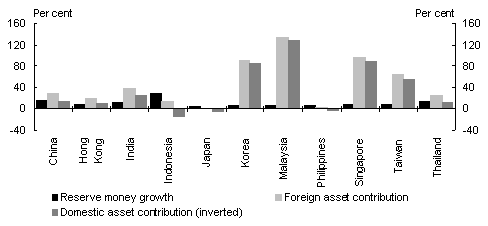
Source: CEIC.
How has intervention affected exchange rates?
The scale of reserve accumulation and the limited recent appreciation of most Asian currencies against the US dollar appear to offer strong evidence that Asian governments have significantly influenced the values of their currencies.
In fact, the issue is less clear-cut than this. First, comparisons of currency movements depend critically on the choice of base date. Chart 5 shows that the euro depreciated much more than most Asian currencies in the period before January 2002 when the USdollar was appreciating. Hence, the choice of a base date when the euro was at a very low point exaggerates its relative rise in the recent period.
Chart 5: Exchange rates, USD/domestic currency
(Jan-99 = 100)
|
|
|
Source: CEIC, OECD Main Economic Indicators. A downward movement represents a depreciation of the domestic currency against the USD.
Second, much of the recent intervention has been sterilised. While economists generally agree that unsterilised intervention (which changes monetary settings) should affect exchange rates, there is no consensus on the effectiveness of sterilised intervention.5
Where capital is mobile, the effects of sterilised intervention might conceivably be negated by the responses of other market participants, given no underlying fundamentals have changed.
That said, it is notable that most Asian economies have avoided significant real appreciations over the period since January 1999. This date is around the point at which Asian currencies stabilised following the 1997-98 financial crises (Chart 6).
Chart 6: Real effective exchange rate changes
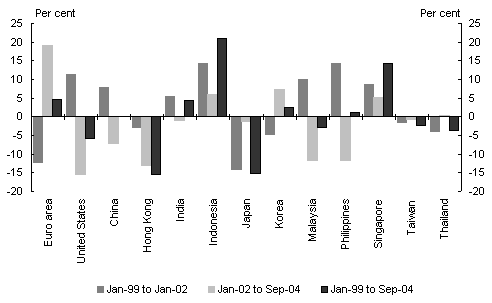
Source: Datastream (JP Morgan trade-weighted index, broad basis). Negative means depreciation.
This is despite the fact that most of these economies have been experiencing relatively strong GDP growth (with the notable exception of Japan) and accumulated current account surpluses over this period (Chart 7). These factors would normally imply a trend to real appreciation over time. In China’s case, this may be at least partly offset by ongoing liberalisation of trade barriers, which tends to depreciate the real exchange rate by shifting domestic spending toward imports.
Chart 7: Current accounts and GDP growth
(average 1999-2003)
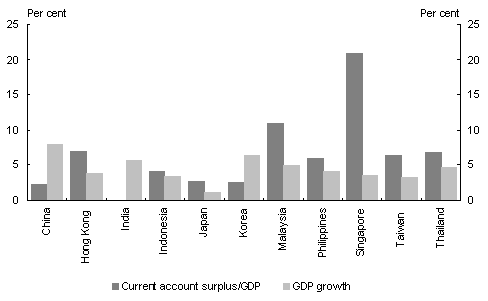
Source: CEIC.
A further a priori reason for believing that recent Asian intervention has been at least somewhat effective is that capital mobility in most Asian economies is lower than in other regions. This reflects factors such as capital account restrictions, less developed financial markets and weaker policy credibility.
What has motivated reserve accumulation in Asia?
Maintaining export-led growth
Most observers see recent reserve accumulation as driven by a desire to maintain competitive exchange rates and, hence, economic growth.
In the short-term, foreign exchange market intervention may help support demand in circumstances where conventional instruments cannot be used effectively. This has been particularly relevant for Japan. Conventional monetary policy has been made ineffective by the zero interest bound and bad loan problems in the banking system, while fiscal policy is constrained by concerns about long-term sustainability.
In the longer term, growth benefits from an under-valued exchange rate depend on supply-side impacts. The thesis of Dooley et al (2003) assumes that a strategy of deliberately under-valuing the exchange rate to promote exports can deliver long-run growth benefits.
Vines (2004) suggests that such a strategy might be justified in terms of an endogenous growth model. An under-valued exchange rate increases profitability in the ‘modern’ export sector, promoting investment in productivity-enhancing technologies that yield ongoing growth benefits. Sufficiently high rates of profit cannot be maintained in the domestic market alone because increased output would push down prices.
Vines notes, however, that sustaining such a strategy is likely to be difficult, requiring a combination of tight fiscal policy, effective capital controls and trade liberalisation measures to offset pressures for real appreciation. These options are discussed further below.
Eichengreen (2004) argues that the export-led growth model, while successful for Asia in the past, may have reached the point of diminishing returns for many Asian economies. First, traditional traded goods are no longer the sole source of knowledge spill overs. These increasingly come from areas like software development, back-office services and financial intermediation. This calls for balanced investment in both traded and non-traded sectors (including human capital).
Second, financial liberalisation has reduced scope to channel savings into investment in the export sector. This increases the risk that abundant credit (driven by reserve accumulation to hold down the exchange rate) spills over into excessive investment in the non-traded sector. Increasing financial openness also makes it harder to sustain under-valued exchange rates due to the difficulty of sterilising resultant capital inflows. This issue is also discussed further below.
Reducing vulnerability to external shocks
Foreign reserves reduce vulnerability to external shocks, particularly for emerging market economies whose access to global financial markets tends to be uncertain and pro-cyclical. Capacity to draw on reserves can help smooth consumption in the face of external shocks and reduce vulnerability to creditor runs arising from currency and maturity mismatches.
The ratio of reserves to short-term external debt is the most widely-used indicator of emerging market vulnerability to capital flight. All emerging Asian economies comfortably meet the benchmark of at least 100percent coverage, in contrast to the situation at the time of the 1997-98 financial crises (Chart 8). Taiwan, India and China, in particular, have quite high ratios. This suggests that limiting vulnerabili
ty probably has not been the primary motive for recent reserve accumulation in most economies.
The IMF (2003) has developed a model that predicts reserve levels based on a range of factors including economic size, indicators of current and capital account vulnerability, exchange rate volatility and interest differentials. This model suggests that reserve build-up in Asian emerging economies from 1998 through to 2001 could be explained by normal economic factors, but accumulation since then appears unusual.
Chart 8: Ratios of reserves to short-term external debt
(end of year)
|
|
|
Source: CEIC, Joint BIS-IMF-OECD-World Bank Statistics on External Debt. Debt due within one year.
Maintaining exchange rate pegs for stability
Reserve accumulation may result automatically from maintaining currency pegs to the US dollar for purposes of financial stability and monetary policy credibility. Pegs may be either ‘hard’ (as for China, Hong Kong and Malaysia) or ‘soft’ (allowing fluctuation within a limited range).
The ‘fear of floating’ hypothesis suggests that emerging economies tend to be reluctant to allow their currencies to fluctuate (Calvo and Reinhardt, 2000). This is said to reflect concerns about price stability and financial vulnerabilities arising from ‘original sin’: that is, limited ability to borrow long-term domestically and in their own currencies externally.
McKinnon and Schnabl (2003) argue that East Asia has adopted hard or soft dollar pegs as a response to a large share of its trade being invoiced in US dollars and ‘original sin’ problems of capital market incompleteness that make hedging difficult. Pegging to the US dollar allows most remaining currency exposures to be hedged in the yen-dollar, euro-dollar and other well-developed markets.
Counter to this view is the argument that pegged or intermediate regimes are difficult to sustain where capital is mobile. Rogoff et al (2003) found that emerging market economies with pegged or intermediate regimes have been more prone to ‘twin’ banking and currency crises. Nor did such regimes appear to provide any significant gain on inflation or average growth for these economies.
On the other hand, developing economies that are less open to capital flows were found to have achieved fewer benefits from such regimes with little cost in terms of growth, volatility or incidence of crises. Hence, sustaining pegs may be easier for economies like China that have maintained capital controls. But this will become more difficult as they become more integrated into international financial markets.
What are the costs of reserve accumulation?
Fiscal costs
Reserve accumulation means higher gross public debt than otherwise. Where intervention is sterilised, debt held by the public is increased. Even if intervention is unsterilised, the monetary base thus created could have otherwise been used to purchase government debt. Fiscal costs will be incurred if the return on foreign reserve assets is less than the government’s borrowing rate.
Chart 9 shows that bond yield differentials with the United States vary significantly across Asia. Some economies have yields close to or below United States yields, and hence would not incur net interest costs from holding reserves. Others have significant positive differentials with the United States: up to around 300 basis points for India.6
Chart 9: Government security yields
|
3 month bills |
2 year bonds |
|
|
|
Source: CEIC, Datastream. ‘2 year’ yields for India and Korea are 1 year.
Chart 10 shows foreign reserves held by Asian economies as a percentage of GDP. Net interest costs for economies with positive interest differentials (India, Korea and Malaysia) appear to be significant but not prohibitive (of the order of 0.4 to 0.6 per cent of GDP). Moreover, part of this would reflect normal prudent requirements, so the fiscal cost of ‘excess’ reserve accumulation would be substantially lower.
Chart 10: Foreign reserves as a percentage of GDP
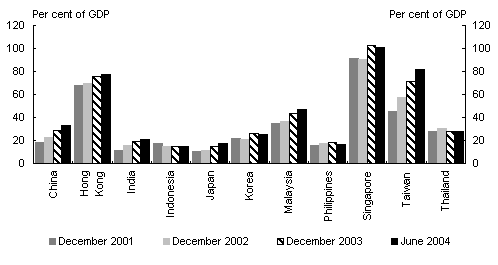
Source: CEIC.
Fiscal costs may also arise from balance sheet exposures. As recent reserve asset accumulation has largely comprised United States securities, declines in either the USdollar or United States bond prices could generate losses.
Central banks whose currencies have appreciated against the US dollar already have unrealised losses on US dollar assets, although these are at least partly offset by gains on euro assets. Euro assets form a much lower share of reserves, but most Asian currencies have depreciated much more against the euro than they have appreciated against the US dollar.
Of course, central banks only recognise losses when assets are realised. They generally avoid losses by holding foreign currency assets until they are appreciating against the domestic currency. But losses will be more difficult to avoid if the long-term trend in the US dollar is downward. Even so, governments’ currency exposures are hedged if they have offsetting US dollar debt exposures. But the biggest interveners — Japan, China, Taiwan, and Korea — have relatively low levels of external government debt.
Economic opportunity costs
In addition to fiscal costs, reserve accumulation may involve real resource costs. There are several aspects to this. First, ‘re-export’ of capital inflows into foreign securities entails a real resource transfer to foreigners when risk-adjusted returns on these assets are lower than the risk-adjusted costs of external borrowing.
Second, domestic investment and consumption may be crowded out if intervention results in higher interest rates and/or a lower exchange rate than otherwise. Such crowding out necessarily occurs when the economy is at full capacity, but it is less likely to be a concern where the economy has spare capacity
.
Third, resource misallocation costs can arise if the lower exchange rate is unsustainable, due to excess investment in tradable goods production capacity.
Loss of monetary policy autonomy
Another potential cost arises from the constraints of the ‘impossible trinity’; that is, the impossibility of simultaneously maintaining both a fixed exchange rate and an independent monetary policy when capital is highly responsive to interest rate differentials. Exchange rate targeting must entail some loss of monetary policy autonomy unless capital mobility can be restricted.
As noted earlier, purchase of reserve assets entails monetary expansion unless sterilised by offsetting sales of government debt. The critical issue is how long Asian governments could maintain control over their monetary policies through sterilisation. In general, the lower the capital mobility, the smaller the BoP surpluses that must be sterilised and hence the longer sterilised intervention can be sustained.
The difficulties of sterilisation, however, increase over time if sterilisation debt grows faster than the rate of liquidity growth consistent with monetary policy objectives. Higher interest rates would eventually be required to induce investors to hold an increasing relative supply of domestic government debt. Unless capital mobility can be restricted, this tends to attract further capital inflows. This can create a vicious circle where increasing sterilisation operations further increase interest rates and attract more capital inflows (including increasing speculative inflows).
In these circumstances, governments would eventually be faced with the choice of either letting their currencies appreciate or allowing monetary growth to increase. In the latter case, they could continue to hold down the nominal exchange rate, but real appreciation would eventually occur through higher inflation.
Are the costs of reserve accumulation increasing?
If accumulation of reserves were becoming more costly, this should be manifested in either rising interest rates (increasing fiscal and economic costs) or excessive monetary expansion and inflationary pressures.
At this stage there is no clear evidence of upward pressure on interest rates in Asia. Chart 9 showed that government bond yields have not significantly increased relative to United States yields. Indeed, real rates in many Asian economies have fallen as inflation rates have increased.
One reason for this may be that many Asian economies have until recently not seen much growth in domestic investment that would otherwise have absorbed liquidity. This may explain why there has been a ready appetite for government debt, avoiding the need for higher interest rates. While investment growth in China has been very strong, administrative controls over credit allocation may, until recently, have helped avoid interest rate increases.
Chart 11 shows that the rate of growth in broad money has increased in some Asian economies over the past 12-18 months, albeit from relatively low rates in some cases. Recent M2 growth has been especially strong in China (albeit slowing recently) and India and has also increased noticeably in Malaysia.
Chart 11: M2 growth
(through the year)
|
|
|
Source: CEIC.
More expansionary monetary conditions have been associated with increasing inflation rates in many Asian economies (Chart 12). This has allowed a number of economies to emerge from an earlier period of actual or near-deflation. While inflation in China has risen to over 5percent through the year, this has been primarily driven by steep increases in food prices. That said, inflation may become more of a concern going forward and tighter monetary conditions may be needed in some economies.
Chart 12: CPI inflation rates
(through the year)
|
|
|
Source: CEIC.
Can recent policies be sustained without increasing costs?
Asian governments may find it more difficult to maintain appropriate monetary conditions in future if they continue to resist currency appreciation. Chart 13 shows that cumulative sterilization operations (based on the approach shown in Chart 4) have grown significantly as a share of broad money in a number of Asian economies. This suggests that recent rates of reserve accumulation in these economies cannot be sustained indefinitely. As economies continue to grow and excess capacity and liquidity are absorbed, continued sterilization on this scale would eventually push up interest rates, leading to the vicious circle process described above.
Chart 13: Cumulative sterilisation since January 2001
(per cent of M2)
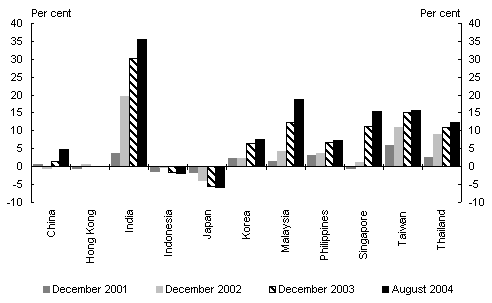
Source: CEIC. Difference between change in net foreign assets and change in reserve money, cumulated from January 2001.
A notable exception has been Japan, which has been accumulating reserves on a large scale while injecting liquidity through open market operations. This reflects Japan’s ongoing deflationary conditions, which have meant that the authorities have not been concerned to limit monetary expansion. This is not likely to become an issue until there is a clear end to deflationary conditions.
Cumulative sterilisation in China is still relatively limited as a share of M2, albeit growing in recent months as the authorities increased efforts to rein in monetary growth. The sustainable rate of reserve accumulation is likely to be higher for a fast-growing economy like China, given liquidity needs will also be growing at a relatively fast pace. Moreover, a rapidly developing economy should be able to sustain a somewhat higher rate of inflation without losing competitiveness.7 China’s stated objective is to keep inflation under 5percent, which could encompass a higher rate of inflation than its trading partners.
Sustainability of US dollar pegs (or quasi-pegs) will depend substantially on the future value of the US dollar. Further dollar depreciation would depreciate effective exchange rates, promoting renewed speculative inflows and further increasing the task of sterilising BoP sur
pluses. It would also increase potential currency losses. Hence, a renewed decline in market confidence in the dollar would make it more costly for Asian policy-makers to continue to resist appreciation. A moderate US dollar appreciation, on the other hand, would relieve upward pressure on Asian currencies.
As noted earlier, pressures for real appreciation might be mitigated through some combination of:
- tightening capital controls to prevent capital inflows responding to interest rate differentials and expectations of appreciation; and
- tightening fiscal policy to push down interest rates and constrain domestic demand; and
- trade liberalisation to shift Asian spending toward imports.
How effective or feasible such measures might be is unclear. Capital controls tend to become less effective over time, particularly as financial markets become more sophisticated and openness to trade increases. Controls in place in China have become somewhat ‘leaky’, and gradual liberalisation will be desirable to assist financial development. While China is selectively reducing controls over foreign currency holdings, the fragility of Chinese banks constrains the pace of such liberalisation.
The impact of tighter fiscal policy may be ambiguous. While fiscal consolidation would be desirable for some Asian economies to ensure fiscal sustainability, a permanent fiscal tightening in these circumstances might boost confidence and put upward pressure on exchange rates. In any case, as the United States and Europe also need to undertake fiscal consolidation over the medium-term, this is likely to be at best a temporary means of avoiding appreciation.
Further trade liberalisation would only be effective if Asia’s trade barriers to the rest of the world were reduced. With the notable exception of China and compared with past experience, Asian economies generally appear to have little appetite for comprehensive unilateral liberalisation. Indeed, as the aim would be to reduce trade surpluses it would only be attractive if policymakers were concerned with export competitiveness per se rather than with net exports.
Conclusions
Notwithstanding the scale of foreign reserve accumulation by Asian governments over the past two years or so, the costs of this policy so far do not appear high. Asian economies have been able to maintain relatively competitive exchange rates without experiencing significant economic pressures in the form of either rising interest rates or high inflation. This has reflected factors such as existing spare capacity and subdued domestic investment in many economies. More expansionary monetary conditions appear to have been beneficial in boosting growth and combating deflation in the region.
Continued reserve accumulation on the recent scale is unlikely to be sustainable indefinitely. The need to sterilise monetary effects of reserve accumulation would eventually put upward pressure on interest rates. This would induce further capital inflows, leading to an increasingly large and costly sterilisation requirement. If reserve accumulation feeds into monetary growth, competitiveness benefits from holding down the nominal exchange rate would eventually be offset through higher inflation.
When such pressures might arise is uncertain, and depends on factors such as: movements of the US dollar; the balance between excess capacity, demand and supply growth in each economy; and the balance between the sterilisation task required to meet monetary policy objectives and available liquidity. In general, there appears to be no urgency for Asian economies to change their foreign reserve accumulation policy in the immediate future, although a further depreciation of the US dollar against other currencies would tend to increase pressures on the current approach.
Policy objectives of Asian governments may also be influenced by the evolution of their economies and by external political pressures from the United States and Europe, although it is difficult to predict how these factors might play out.
Japan may be less concerned about yen appreciation if the current recovery consolidates and deflationary conditions come to an end. The costs of continuing to resist appreciation may then loom larger in policy calculations. But whether the recent fall in Japan’s foreign exchange market intervention presages such a policy shift will only be tested if the US dollar starts to depreciate again.
China has signalled its intention to move to a more flexible exchange rate regime over time, which could see it reduce its accumulation of reserves.
References
Bank for International Settlements 2004, Annual Report 2003-04.
Calvo, Guillermo and Reinhardt, Carmen 2000, ‘Fear of Floating’, National Bureau of Economic Research Working Paper 7993.
Dooley, Michael, Folkerts-Landau, David and Garber, Peter 2003, ‘An Essay on the Revived Bretton Woods System’, National Bureau of Economic Research Working Paper 9971.
Dooley, Michael, Folkerts-Landau, David and Garber, Peter 2004a, ‘The Revived Bretton Woods System: The Effects of Periphery Intervention and Reserve Management on Interest Rates and Exchange Rates in Centre Countries’, National Bureau of Economic Research Working Paper 10332.
Dooley, Michael, Folkerts-Landau, David and Garber, Peter 2004b, ‘Revived Bretton Woods End Game: Direct Investment, Rising Real Wages and the Absorption of Excess Labour in the Periphery’, Prepared for IMF Conference in Honour of Guillermo Calvo, Washington DC, April 15-16.
Eichengreen, Barry 2004a, ‘Chinese Currency Controversies’, paper presented to the Asian Economic Panel, Hong Kong, 12-13 April.
Eichengreen, Barry 2004b, ‘Global Imbalances and the Lessons of Bretton Woods’, National Bureau of Economic Research Working Paper 10497.
Fatum, Rasmus and Hutchison, Michael 2003, ‘Effectiveness of Official Daily Foreign Exchange Market Intervention Operations in Japan’, National Bureau of Economic Research Working Paper No. 9648.
International Monetary Fund 2003, ‘Are Foreign Exchange Reserves in Asia Too High?’, Chapter II, World Economic Outlook September 2003.
Ito, Takatoshi 2002, ‘Is Foreign Exchange Intervention Effective? The Japanese Experiences in the 1990s’, National Bureau of Economic Research Working Paper 8914.
McKinnon, Ronald and Schnabl, Gunther 2003, ‘The East Asian Dollar Standard, Fear of Floating and Original Sin’, http://www.stanford.edu/~mckinnon/papers.htm.
Ramaswamy, Ramana and Samiei, Hossein 2000, ‘The Yen-Dollar Rate: Have Interventions Mattered?’, IMF Working paper WP/00/95.
Rogoff, Kenneth; Husain, Aasim; Mody, Ashoka; Brooks, Robin and Oomes, Nienke 2003, ‘Evolution and Performance of Exchange Rate Regimes’, IMF Working Paper WP/03/243.
Vines, David 2004, ‘Pegged Exchange Rates, Export-led Growth and Capital Controls: Managing a Revived Bretton Woods System in the Asia Pacific Region’, presented to a conference on ‘Practical Steps Towards East Asian Integration’, Tokyo, 25-26 March.
1 The author is from International Economy Division, Australian Treasury. This article has benefited from comments and suggestions provided by Gordon de Brouwer, David Gruen and Heather Smith, and from data assistance provided by Jennifer Chang. The views in the article are those of the author and not necessarily those of the Australian Treasury.
2 In order to present a more accurate picture of underlying trends, Chinese data in this article are adjusted for the allocation of US$45 billion in foreign reserves to recapitalise Chinese banks in December 2003. This reduced me
asured changes in reserves and increased measured outflows of non-FDI capital in the relevant period.
3 The BIS (2004) estimates that US dollar reserves accounted for 88percent of the change in world reserves (at constant exchange rates) in 2003. Asia accounted for 87percent of the change in world reserves (in SDR terms) in 2003.
4 Japan’s interventions are largely conducted through the Ministry of Finance’s Special Account Fund, and do not automatically affect the monetary base. In the case of China, this approach does not capture the effects of increases in required reserve ratios from 6 to 7percent in September 2003, and again to 7.5percent (8percent for weak banks) in April2004. These aim to prevent increases in the monetary base feeding through to broader monetary aggregates.
5 Sterilised intervention may affect the exchange rate through two main channels.
(i) Portfolio balance channel. Sterilised intervention reduces the supply to the market of foreign bonds and increases the supply of domestic bonds. Where these assets are imperfect substitutes this increases the relative risk premium on domestic bonds, pushing the exchange rate down and the domestic interest rate up.
(ii) Signalling channel. Intervention may be read by financial markets as a signal of future monetary policy intentions.
6 Foreign reserve assets are generally of shorter maturities, as are securities used by central banks for sterilisation operations. While data on shorter-term yields is not available for China, long-term yields during this period have generally been 150-200 basis points above US yields. Indonesia and the Philippines also have large interest rate differentials but are excluded as their recent accumulation of reserves has been much less significant.
7 This reflects the so-called Balassa-Samuelson effect. Productivity catch-up in the traded goods sector tends to drive real appreciation as economies develop. This can occur through nominal appreciation or, if this is prevented, through higher inflation relative to trading partners. Higher traded sector productivity pushes up wages across the economy, increasing unit labour costs in the non-traded sector relative to the traded sector.
